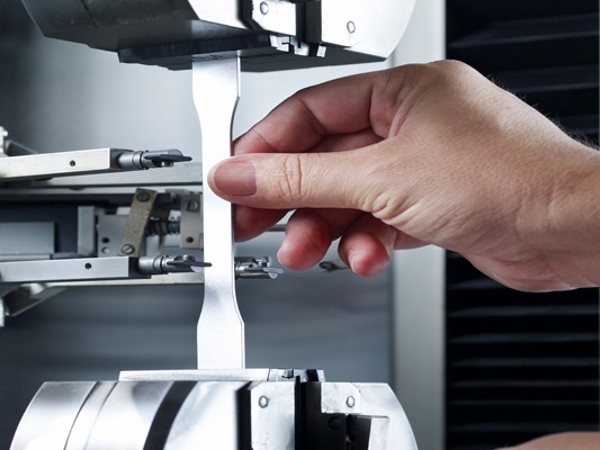Resources
- Literature , Guidelines, Forms
All kinds of resources have been provided below to help make your experience with ATIS easy, efficient and informative. Just click the links for easy online access.
BROCHURES
- Testing Services
- Destructive/Nondestructive
FORMS
- New Customers
- Customer Information Form
- Standard Terms & Conditions
ADDITIONAL INFORMATION
- Testing Services
- Material Size Requirements
- Sample Sizes for Testing
ACCREDITATION CERTIFICATES
- New Customers
- Mechanical Testing
- Chemical Testing
- Material Testing Glossary
MATERIALS TESTING TERMINOLOGY
The following glossary of terms and definitions contains many expressions that are heard and seen often.
1. CHEMICAL TESTING
⦁ Reference Material is a material or substance that has one or more sufficiently homogeneous and well established property values so that it may be used to calibrate an analytical instrument, to assess a measurement method, or to assign values to test samples.
⦁ Certified Reference Material has its composition certified by a recognized standardizing agency, such as the National Institute of Standards and Technology.
⦁ Optical Emission Spectrometry (OES) makes use of the principle that free atoms when energized emit light at a particular narrow band of wavelength intervals. The interval or emission lines form a pattern that is characteristic of the atom that produced it. The intensities of the lines are proportional to the number of atoms that produced them and thus to the elements present. The concentration of the element can be determined by measuring the line intensities. OES is used to measure major and trace elemental constituents in metal alloys. Some elements are difficult or impossible to determine using OES. These include nitrogen, oxygen, hydrogen, halogens, and noble gases.
2. MECHANICAL TESTING
⦁ Ductility is the ability of a metal to deform to a permanent position before it fractures.
⦁ Elastic Limit is maximum stress that a material can sustain without any permanent deformation remaining after complete release of the stress.
⦁ Elongation at Break or Total Elongation is the amount of permanent deformation determined after fracture by realigning and fitting together the broken ends of the specimen.
⦁ Elongation at Fracture or Maximum Elongation is measured at the time of fracture and includes both permanent and elastic deformation of the tensile specimen. This is usually determined by keeping an extensor on the specimen through the final fracture.
⦁ Gauge Length is the original length of that portion of the specimen over which the strain or the change of length is determined.
⦁ Hardness is the resistance of a material to deformation, particularly permanent deformation, indentation or scratching.
⦁ Mechanical properties: – Those properties of a material that are associated with the elastic and plastic reaction when force is applied.
⦁ Mechanical Testing – Mechanical properties of a metal or material relate to its behavior when subjected to a force or load during testing. In mechanical testing, the behavior of the metal is either elastic or inelastic. Elastic behavior occurs with no permanent damage to the test sample. In contrast, inelastic behavior is observed when a material is permanently deformed by the applied force, and therefore, does not return to its original shape.
⦁ Physical Testing – Physical properties are determined without the application of force to the test sample and are usually insensitive to the internal or atomic structure of the material. These properties include density, thermal and electrical conductivity, the coefficient of thermal expansion, magnetic permeability, melting temperature and freezing temperature of materials.
⦁ Plastic strain ratio – The ratio of the true strain in the width direction to the true strain in the thickness direction of a sheet material loaded beyond yield.
⦁ Reduction of Area is the difference between the original cross sectional area of the tension test sample and the area of its smallest cross section after fracture. Reduction of area is expressed as a percentage of the original cross section.
⦁ Ultimate Tensile Strength is the maximum tensile stress that a material is capable of sustaining and is calculated as the maximum load during a tension test carried to rupture, divided by the original cross sectional area of the sample.
⦁ Yield Strength is the engineering stress at which the permanent elongation of the sample has begun.
⦁ Yield by Extension under Load is the engineering stress at which the permanent elongation of the sample has begun as determined by constructing a line perpendicular to the strain axis of a stress strain curve at a strain that is specified as a percentage of the gage length.
⦁ Young’s Modulus of Elasticity is the ratio of the stress to the corresponding strain below the proportional limit and the greatest stress that the sample can sustain without deviation from a linear relationship of stress to strain.
3. METALLURGICAL EXAMINATION
⦁ Austenitic Grain Size is the grain size of a steel sample which exists or existed in the austenite phase at a given temperature. ASTM Test Method E112 discusses methods to determine grain size of steel samples.
⦁ Cold Worked Structure is a micro structure resulting from permanent deformation of a metal or alloy. It is characterized by elongated grains in the material.
⦁ Decarburization is the carbon loss from the surface of a steel part due to the reaction with one or more chemical substances during the heat treatment of the part. Partial decarburization is where the carbon content is less than the unaffected interior portion of the piece. Complete decarburization is where the carbon content is less than the solubility limit of carbon in ferrite so that only ferrite is present at the surface of the piece.
⦁ Duplex Grain Size is the presence of two grain sizes, in substantial amounts, with one size significantly larger than the other.
⦁ Etching is the controlled preferential attack on a metal surface for the purpose of revealing structural details such as grain size or second phases such as carbides.
⦁ Ferrite Grain Size is the grain size of the ferrite in predominantly ferritic steel.
⦁ Flow Lines are the resulting fiber pattern observed in a hot or cold worked material, showing the manner in which the metal flowed during the forming process.
⦁ Inclusions are foreign material in the structure of metals. They are usually referred to as non-metallic particles, such as oxides, sulfides, silicates and aluminates.
⦁ Macroetch is the controlled surface etching of a metallic sample to reveal a structure that is visible at low magnification, usually no greater than 10 times. It is used to show flow lines and ingot patterns.
⦁ McQuaid-Ehn Grain Size is the austenitic grain size in steels from carburizing at 1700°F followed by slow cooling. The method is described in ASTM E 112 and is used to determine if the steel was made to fine grain practice.
⦁ Metallography is the branch of science which relates to the constitution and structure of metals and alloys, and their relationship to the properties of the material.
⦁ Microstructure is revealed by examining a suitably etched metal sample with a microscope.
⦁ Photomacrograph is a photograph taken at low magnification to show the macrostructure of a suitably etched sample.
⦁ Photomicrograph is a photograph taken at a relatively high magnification (50 times or greater) to show the microstructure of a suitably polished and etched sample.
⦁ Polishing is a mechanical, chemical, and/or electrolytic process used to prepare a smooth reflective surface free from artifacts or damage introduced during sectioning or grinding and suitable for microscopic examination.
⦁ Recrystallization is the formation of a new grain structure through nucleation and growth that is produced by subjecting a rolled or formed metal to elevated temperature for a time long enough to accomplish the change in the structure.
⦁ Segregation is the concentration of alloying elements in specific regions in a metal which causes variations in the etching characteristics of the sample.
⦁ Vickers Hardness is a type of diamond hardness measurement similar to Knoop hardness, but with an indenter that has equal length sides and looks diamond shaped.
4. NONDESTRUCTIVE TESTING
⦁ Defect is any discontinuity that does not meet the specified acceptance criteria.
⦁ Discontinuity is an intentional or unintentional interruption in the physical structure or configuration of the material or component.
⦁ False indications are NDT indications caused by conditions such as part geometry (blind holes, keyways), magnetic writing, localized hardening and scratches. They are considered non-relevant.
⦁ Indication is the response or evidence from a nondestructive examination.
⦁ Interpretation is a determination of whether indications are relevant, non-relevant or false.
⦁ Leakage field is the magnetic field that leaves or enters the surface of a part as a result of a discontinuity or change of section.
⦁ Non-relevant indication is an NDT indication that is caused by a condition or type of discontinuity that is not rejectable.
⦁ Relevant indication is an NDT indication that is caused by a condition or type of discontinuity that requires evaluation.
CONTACT US ANYTIME
We’re here to help you meet your quality requirements.

